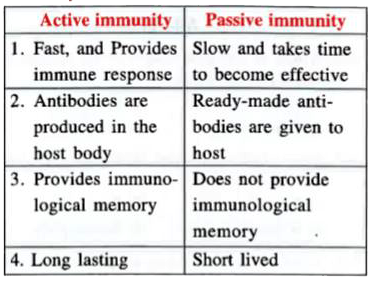Differentiate between active immunity and passive immunity.
Step-by-Step Text Solution
1. Definition of Immunity:
- Immunity is the body's ability to resist or defend against foreign substances, such as pathogens (bacteria, viruses) or toxins.
2. Active Immunity:
- Development: Active immunity is developed when a person is exposed to a pathogen or antigen. This exposure can occur through infection or vaccination.
- Mechanism: The immune system responds by producing its own antibodies and memory cells that provide long-term protection.
- Side Effects: Generally, there are no significant side effects since it is the body's own immune response.
- Response Time: The development of active immunity is a slow process, taking days to weeks to build up.
- Duration of Protection: It provides long-lasting immunity, often for years or even a lifetime.
3. Passive Immunity:
- Development: Passive immunity is acquired when a person receives ready-made antibodies from an external source, such as through an injection.
- Mechanism: This type of immunity does not involve the recipient's immune system actively producing antibodies; instead, it relies on the antibodies provided.
- Side Effects: There may be side effects, including allergic reactions to the injected antibodies.
- Response Time: Passive immunity provides a fast response, as the antibodies are already formed and ready to act.
- Duration of Protection: The immunity is short-lived, typically lasting only a few days to months.
4. Examples:
- Active Immunity Example: Vaccination against polio, where the body produces its own antibodies in response to the vaccine.
- Passive Immunity Example: Administration of tetanus antitoxin, where pre-formed antibodies are injected into the body.
Summary of Differences
| Feature | Active Immunity | Passive Immunity |
|----------------------|-----------------------------------------|----------------------------------------|
| Development | Exposure to pathogen/antigen | Injection of ready-made antibodies |
| Mechanism | Body produces its own antibodies | Antibodies are provided externally |
| Side Effects | Minimal side effects | Possible allergic reactions |
| Response Time | Slow (days to weeks) | Fast (immediate effect) |
| Duration of Protection| Long-lasting (years/lifetime) | Short-lived (days to months) |
| Examples | Vaccination (e.g., polio) | Antibody injections (e.g., tetanus) |
- Immunity is the body's ability to resist or defend against foreign substances, such as pathogens (bacteria, viruses) or toxins.
- Development: Active immunity is developed when a person is exposed to a pathogen or antigen. This exposure can occur through infection or vaccination.
- Mechanism: The immune system responds by producing its own antibodies and memory cells that provide long-term protection.
- Side Effects: Generally, there are no significant side effects since it is the body's own immune response.
- Response Time: The development of active immunity is a slow process, taking days to weeks to build up.
- Duration of Protection: It provides long-lasting immunity, often for years or even a lifetime.
- Development: Passive immunity is acquired when a person receives ready-made antibodies from an external source, such as through an injection.
- Mechanism: This type of immunity does not involve the recipient's immune system actively producing antibodies; instead, it relies on the antibodies provided.
- Side Effects: There may be side effects, including allergic reactions to the injected antibodies.
- Response Time: Passive immunity provides a fast response, as the antibodies are already formed and ready to act.
- Duration of Protection: The immunity is short-lived, typically lasting only a few days to months.
- Active Immunity Example: Vaccination against polio, where the body produces its own antibodies in response to the vaccine.
- Passive Immunity Example: Administration of tetanus antitoxin, where pre-formed antibodies are injected into the body.
|----------------------|-----------------------------------------|----------------------------------------|
| Development | Exposure to pathogen/antigen | Injection of ready-made antibodies |
| Mechanism | Body produces its own antibodies | Antibodies are provided externally |
| Side Effects | Minimal side effects | Possible allergic reactions |
| Response Time | Slow (days to weeks) | Fast (immediate effect) |
| Duration of Protection| Long-lasting (years/lifetime) | Short-lived (days to months) |
| Examples | Vaccination (e.g., polio) | Antibody injections (e.g., tetanus) |
Topper's Solved these Questions
Similar Questions
Which of the following is not a correct difference between active immunity and passive immunity

View SolutionDefine immunity. Describe different ways to develop immunity. Write two differences between active and passive immunity.
View SolutionMention one significant difference between active acquired immunity and passive acquired immunity.
View SolutionDifferentiate between an artery and a vein.
View SolutionDifferentiate between a mineral and an ore.
View SolutionDifferentiate between elements and compounds
View SolutionDifferentiate innate and acquired immunity.
View SolutionGive one significant difference between the following: Active immunity and Passive immunity
View SolutionPassive immunity is defined as immunity
View SolutionDifferentiate between an acid and a base
View Solution
